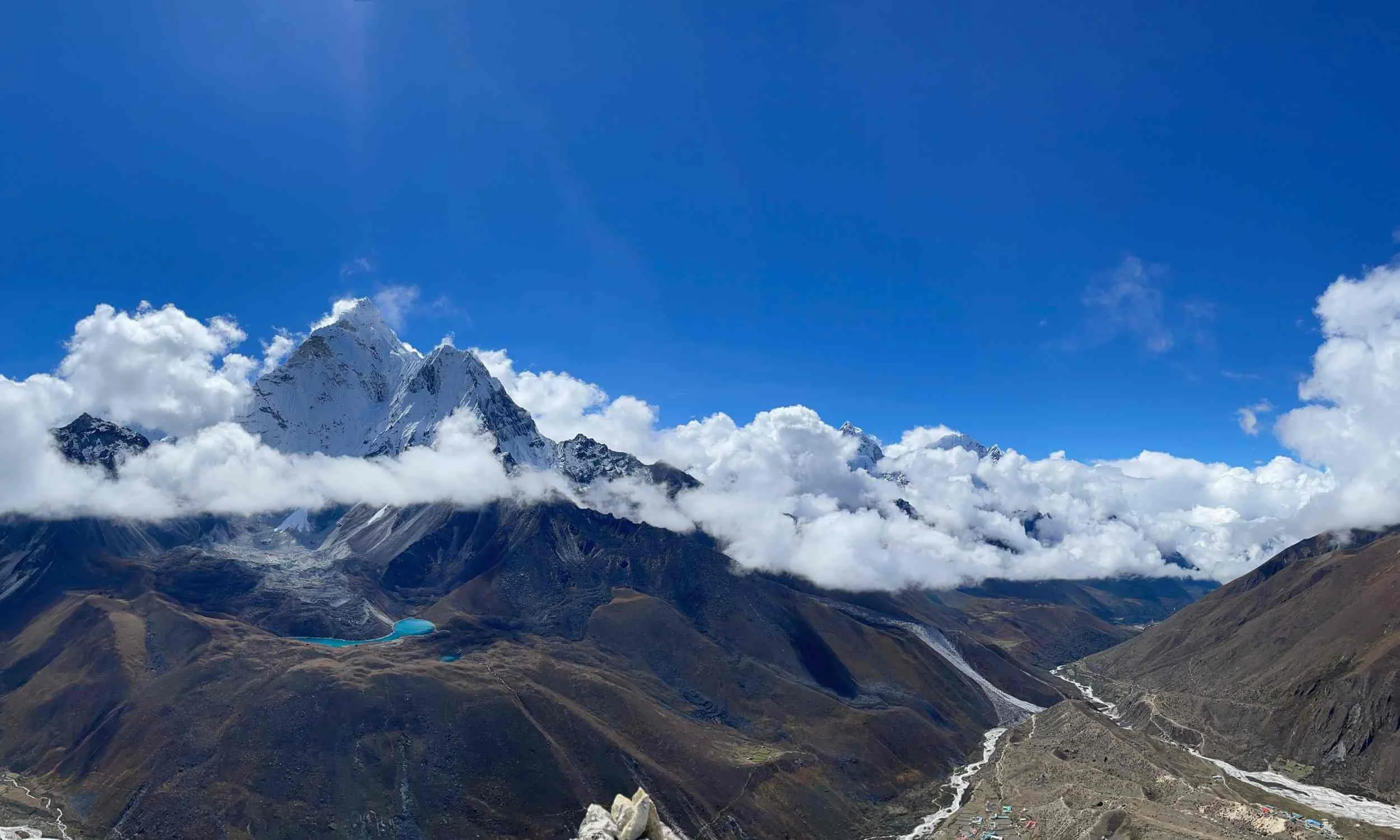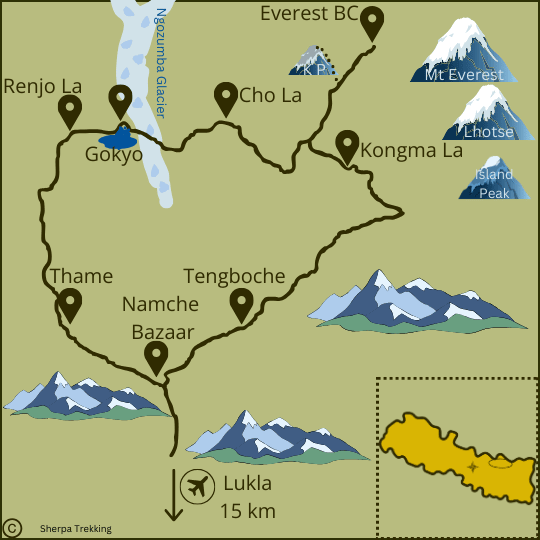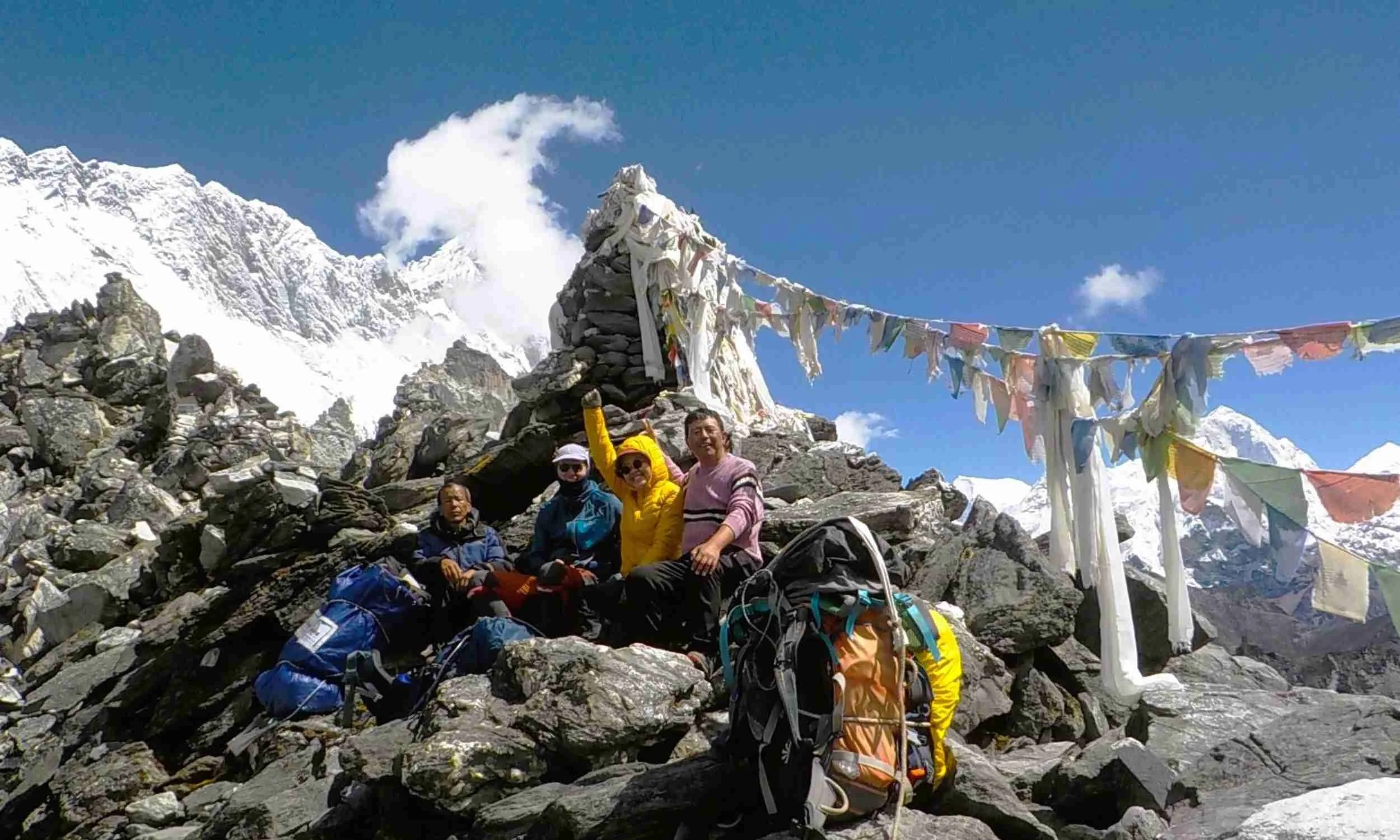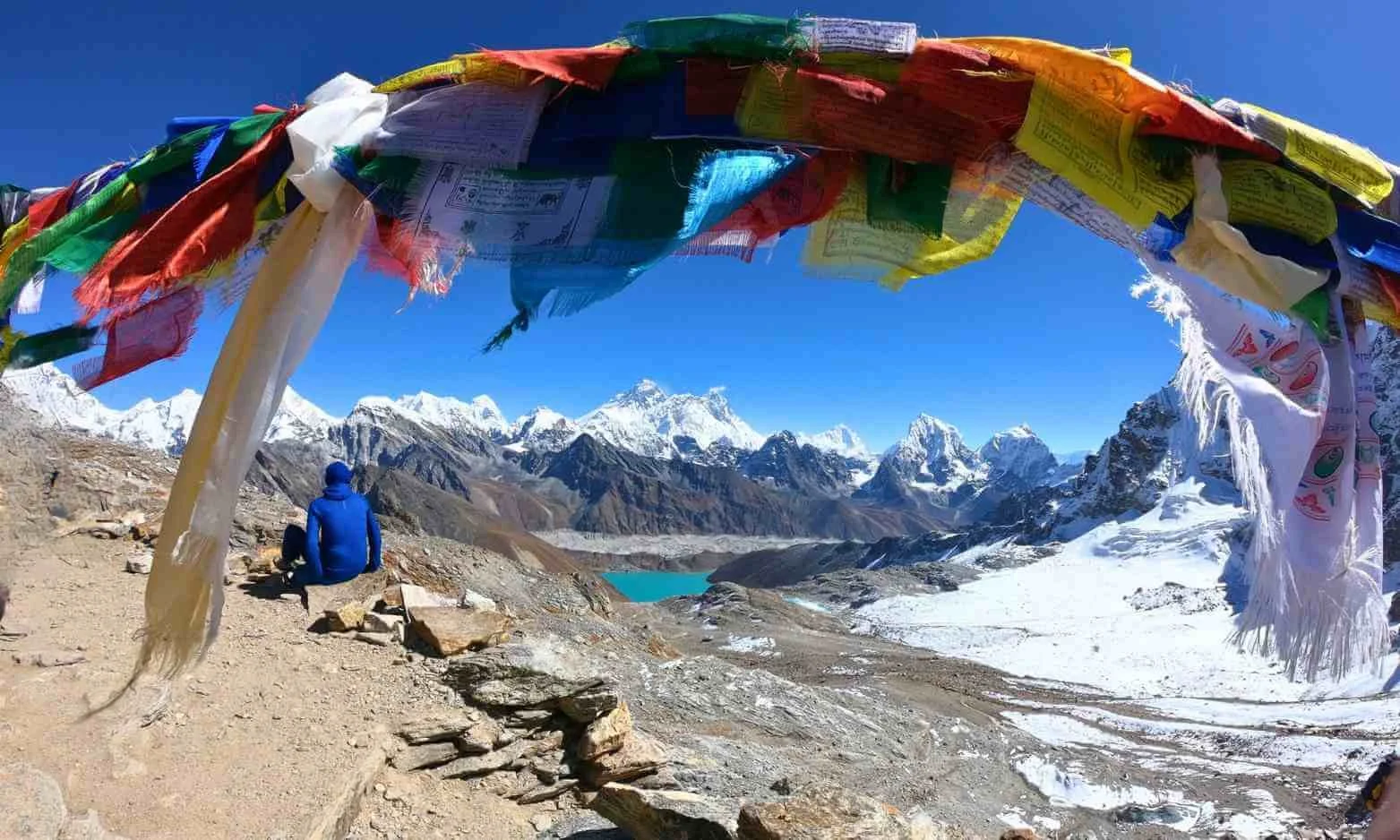Explore Nepal's Three Passes Trek
in the Khumbu
Overview of the
Everest Three Passes Trek
The Everest Three Passes Trek, locally known as the Three Passes trek, offers adventurers an immersive experience in the breathtaking Khumbu region. This challenging journey is not only a test of physical endurance but also a remarkable opportunity for discovery and connection. Trekking through the heart of the Khumbu, you'll explore regions far beyond the popular routes to Everest Base Camp.
It encompasses the crossing of the Renjo La, Cho La, and Kongma La passes, each presenting a challenge and offering awe-inspiring vistas of Everest and the encompassing peaks of the Khumbu. The option to ascend Gokyo Ri, Kala Patthar, and Chukung Ri adds an extra layer of adventure, presenting unparalleled views of the Himalayan giants.
The Everest 3 passes begin with a flight from Kathmandu to Lukla, marking the start of a remarkable adventure. Following the Dudh Kosi River, you'll make your way to Namche Bazaar, the gateway to the Khumbu region. After allowing time for acclimatisation in Namche, your steps will lead you towards Thame and onwards to the Renjo La Pass at 5,360 meters.
The first crossing of your Three Passes trek. A long descent from the pass brings you to Gokyo at 4,790 meters, where two nights are spent acclimatising before tackling the Cho La Pass at 5,420 meters and descending to Dzongla at 4,830 meters.
From Dzongla, the path leads to Lobuche at 4,940 meters and subsequently to Gorak Shep at 5,140 meters. A short jaunt from here takes you to Everest Base Camp at 5,364 meters, allowing you to soak in the magnificent views of the Khumbu Icefall and its surrounding summits.
After revelling in these vistas, you'll return to Gorak Shep for the night, before embarking towards Kala Patthar for a striking view of Mount Everest. Next, conquer Kongma La, the culmination of the Everest Three Passes trek. The return trail to Namche and Lukla is gradual, with a reflective pause at the monastery of Tengboche.
This entire journey leads you through remote valleys, vibrant Sherpa communities, and serene monasteries, ultimately deepening your appreciation for Nepal's natural beauty and cultural richness.
Experience the Majestic Khumbu with the Everest Three Passes Itinerary
Illuminating the path less travelled, let us embark on a meticulously curated journey through the heart of the Himalayas. Our Everest Three Passes trek itinerary is designed to immerse you deeply into the splendour of Nepal.
The Everest Three Passes trek is a challenging and rewarding journey that takes you through some of the most beautiful landscapes in the world. This itinerary has been carefully designed to provide an authentic experience of the Khumbu region, while also allowing for ample time to acclimatise at each altitude.
You will be able to explore remote valleys, vibrant Sherpa communities, and serene monasteries as you make your way from Namche Bazaar to Lukla via the high passes.
Everest Three Pass itinerary:
Day 01: Welcome to Kathmandu, the vibrant capital of Nepal. Our team ensures a smooth transition from the airport to your hotel in the bustling Thamel district.
Day 02: Finalize your preparations for the Everest Three Passes trekking adventure. This day is dedicated to ensuring you are fully equipped and briefed for the journey ahead.
Day 03: Begin your journey with a drive to Ramechap airport, followed by a short flight to Lukla. Your first steps on the Three Passes trek in Nepal will lead you to Phakding.
Day 04: The trek to Namche Bazaar unveils the splendour of the Himalayas. This segment of the journey through the Khumbu's majestic high passes beckons you to rise to 3440 meters, embracing a hike of roughly 5 hours.
Day 05: Namche Bazaar serves as your acclimatisation haven. Opt for a day hike to the Everest View Hotel to gently adapt to the elevation.
Day 06: Your progression continues to Thame. This marks a significant stride in your Everest Three Passes itinerary, ascending to 4200 m in roughly 4 hours.
Day 07: Venture towards Lungdhen, elevating to 4380 m through a 6-hour trek. Every step brings new vistas and challenges on this incredible journey.
Day 08: Dedicate your day to acclimatisation with a light hike. It’s essential for adjusting to the thinning air and preparing for the ascents ahead.
Day 09: The Renjo La pass awaits, a pinnacle at 5344 m leading to the mesmerising Gokyo Lakes. The 9-hour trek is both challenging and rewarding, a highlight of the Everest Three passes trek.
Day 10: Embrace a day of rest or opt for an ascent to Gokyo Ri. This optional climb offers unparalleled views of the Everest panorama.
Day 11: Journey to Thangnang, a serene stage set at 4750 m completed in approximately 3 hours. Each step on the Three Passes trek is a story unfolding.
Day 12: Conquer the Cho La pass, elevating to 5367 m and then descending to Lobuche. This day encapsulates the essence of the Everest Three Passes trekking experience over 7 hours.
Day 13: The trail to Gorakshep unfolds over 5 hours. It leads you closer to the heart of the Everest region on this Everest 3 passes journey.
Day 14: Everest Base Camp awaits, an iconic milestone of the Three Passes trek. Return to Gorakshep for the night after a 6-hour trek, marking a pivotal moment in your adventure.
Day 15: Ascend Kala Patar for awe-inspiring views, then retreat to Lobuche. This 6-hour leg of the trek offers one of the most breathtaking perspectives of Everest.
Day 16: Cross the Kongma La pass to Chhukung, an essential segment of your Everest Three Passes itinerary across 7 hours. The pass stands formidable at 5535 m.
Day 17: Consider an optional ascent to Chhukung Ri before trekking to Dingboche. This day combines challenge with stunning landscapes, embodying the spirit of the Khumbu region.
Day 18: Descend to Namche Bazaar via the spiritual Tengboche Monastery. This 6-hour journey back intertwines cultural depth with breathtaking nature.
Day 19: Your return trek to Lukla encapsulates the end of this monumental journey. Reflect on your incredible Everest Three Passes trekking experience over 5 hours.
Day 20: Fly from Lukla to Ramechap, then drive to Kathmandu. This transition from the serenity of the mountains back to the capital marks the conclusion of your physical journey.
Day 21: Revel in a free day at leisure in Kathmandu. Explore, reflect, and relax as you assimilate the profound experiences of your trek.
Day 22: Departure day. Our team ensures a seamless journey from your hotel to the international airport. Your Everest Three Passes trek may conclude here, but the memories and connections last a lifetime.
Navigating the
Three Passes Trek Map
The Three Passes Trek map is your gateway to navigating through the captivating terrains of the Everest region. It charts a path through diverse landscapes, from lush valleys and traditional Sherpa villages to rugged high mountain passes and serene glacial lakes.
It is a map that not only marks your trail but also guides you to the rich tapestry of biodiversity and the cultural waypoints that are the soul of the Khumbu region. It is a helpful tool that leads you to the heart of local life, unveiling the oft-missed nuances that make the Everest Three Passes Trek a true journey of discovery and connection.
This basic map outlines this route, inviting you to an unparalleled exploration. Beyond its navigational function, the Three Passes trek map is not a tool for navigation but a promise of the adventures and stories that lie in wait along this less-travelled path.
Understanding Altitude on
the Everest Three Passes
Altitude is a significant factor to consider when planning your Everest Three Passes Trek, with the journey reaching elevations above 5,000 meters. Acclimatisation days are thoughtfully integrated into the itinerary, allowing your body to adjust to the higher elevations and ensuring a safer and more enjoyable trek.
The journey's high points, which include the crossing of three high mountain passes and optional peak ascents, offer not only breathtaking views but also a sense of accomplishment unlike any other.
Best Season for the
Three Passes Trek in Nepal
The best time to embark on the Everest Three Passes Trek is during the spring (March to May) and autumn (September to November) seasons.
These months offer the most favourable weather conditions for the Three Passes trek, with clear skies, tempered climates, and the most vibrant views of the Khumbu region.
Each season brings its unique palette and experiences, from the blooming rhododendrons of spring to the crisp and clear post-monsoon skies of autumn.
Costs of the Three Passes Trek: What’s Included and What’s Not
he cost of the epic adventure is tailored to reflect the unique demands of navigating this extensive and challenging route. Given the variations in trekking seasons, group sizes, and the logistical requirements of the Everest 3 passes trek, we provide a base price with potential adjustments that may apply depending on specific trekking conditions.
What’s Included:
· Airport Pickup: Upon your arrival at Kathmandu airport, a seamless transfer to your hotel awaits, setting the stage for your upcoming adventure.
· Kathmandu-Lukla Transportation: Secure and efficient transport arrangements to ensure a smooth passage to the starting point of your trek.
· Kathmandu Accommodations: Enjoy a relaxing four-night stay in a reputable Thamel hotel, complete with breakfast, as a prelude to your Everest Three Passes trekking experience.
· Teahouse Lodging: Submerge yourself in authentic Nepalese culture with overnight stays in local teahouses, experiencing unmatched hospitality.
· Meals on Trek: A full board provision (breakfast, lunch, and dinner) to keep you energized and focused on the challenging yet rewarding journey ahead.
· Professional Guide: Our certified, English-speaking guides, deeply knowledgeable about the Everest Three Passes trek route, will lead your adventure.
· Porter Service: Reliable porter assistance, handling up to 10 kg of your luggage per trekker, allowing you to trek with ease and comfort.
· Trekking Permits: We facilitate all necessary permits for the Everest Three Passes trek, including access to Sagarmatha National Park, TREK card, and local taxes.
· Local Support: Our dedicated Sherpa Trekking team in Kathmandu will provide unwavering support throughout your trek, enhancing your experience and ensuring safety.
What’s Not Included:
· International Flight to Kathmandu: Guests are responsible for their travel arrangements to Nepal.
· Nepal Entrance Visa: Required upon your arrival, this visa is essential for your participation in the Everest three passes trek.
· Meals in Kathmandu: While breakfast is provided, lunches and dinners in Kathmandu offer you the flexibility to explore a variety of local culinary delights.
· Personal Expenses During Trek: Any personal expenses such as beverages, hot showers, internet services, laundry, and battery charging along the trek are not covered.
· Personal Travel Insurance: It is crucial to secure travel insurance, which is not included in our package but is essential for your safety.
· Rescue Operation Expenses: Costs that may arise from emergency rescue operations during the trek are not covered under the trek fee.
· Unforeseen Costs: Any unexpected expenses due to delays, itinerary changes, or natural calamities will be additional.
· Gratuities: While not included, tips for your mountain guide and porter are greatly appreciated should you wish to reward their invaluable support and guidance.
Every aspect of the Everest Passes experience is intentionally crafted to deliver an immersive and fulfilling journey. It ensures a safe passage through some of the world's most breathtaking landscapes, promising a deeply authentic encounter with the natural beauty of Nepal.
Choosing Sherpa Trekking for your Everest Three Passes adventure guarantees more than just a journey through Nepal's sublime landscapes. It ensures a profound, meaningful immersion into the very heart of the Himalayas.
With us, you venture beyond mere sightseeing. You engage directly with the vibrant cultures and communities that define this region, guided by experienced and passionate locals. Our attentiveness to detail ensures a balance between challenge and discovery, crafting an experience that is both comprehensive and carefully curated.
Safety, respect for local cultures, and environmental stewardship are at the core of our philosophy, making your journey both a personal pilgrimage and a contribution to sustainable tourism in this magnificent corner of the Earth.





